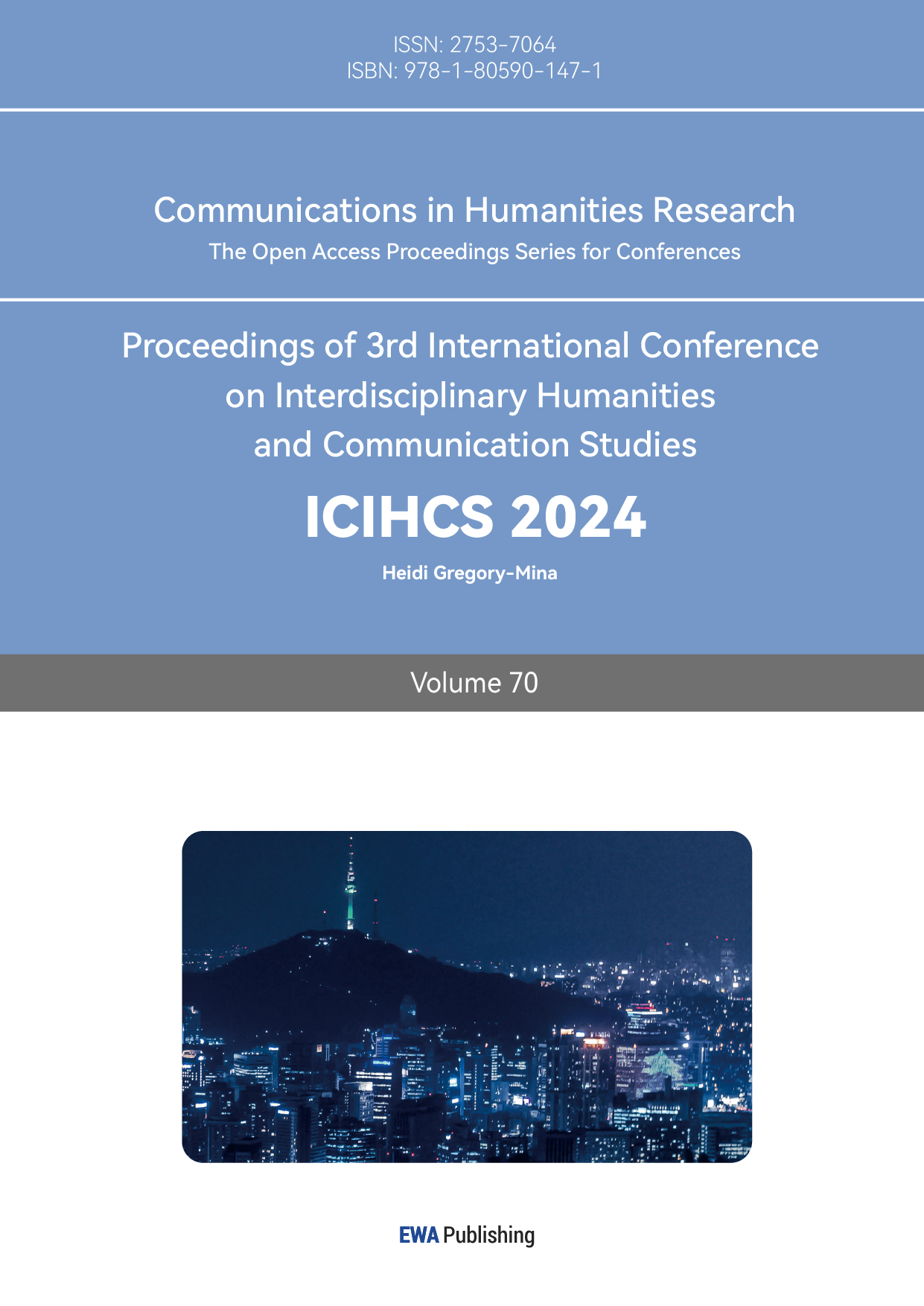1. Introduction
The purpose of the study is to explore the impact of director's gender on the construction of characters in cinemas about lesbian. Furthermore, this paper argues that male directors are unable to evade the male gaze when creating cinemas focusing on lesbian. Laura Mulvey [1] presented the concept of male gaze for the first time in ‘Visual Pleasure and Narrative Cinema’ and pointed out mainstream cinema is often structured around a male spectators' perspective, objectifying female characters and shaping narratives to cater to male desires. Subsequently, the concept of male gaze has been employed to examine the study of diverse film genres from a gender perspective. Moreover, among cinema research, cinema looking at lesbian is an important area of study. However, as evidenced by the analysis of the data from the papers provided by Web of Science, although there are many academic explorations related to the male gaze in cinemas, most of the research usually don’t study the impact of directors’ gender on movies. For example, Wheeler [2] discussed and compared the male gaze between Blue Is the Warmest Color (Kechiche, 2013) and Carol (Haynes, 2015). Both films were directed by male directors, thus showing that director’s gender doesn’t be treated as an influencing factor on the male gaze. Therefore, it is of great significance to study the influence of director's gender on the portrayal of characters in cinemas about lesbian. Fingersmith (Walsh, 2005) directed by a British female heterosexual director and The Handmaiden (Park, 2016) directed by a Korean female heterosexual director are both adapted from the same novel. Fingersmith (Walsh, 2005) tells the story that the Maid helps the gentleman to cheat the Lady out of her property, but the Lady and the Maid get together finally. The Handmaiden (Park, 2016) recounts the tale of the Maid who assists the fake count in defrauding the Lady of her fortune during the 1930s, but the Lady and the Maid eventually fall in love with each other and flee to Shanghai. This paper will compare and analyze these two cinemas in terms of four parts, including intimacy that concludes male directors tend to present the sexual impulses of the lady and the maid through close-up of sexual organs and sexual symbols, sex that concludes male directors highlight the impact of gender on the depiction of women’s bodies, emotional depth, and power dynamics, betrayal that concludes male directors tend to rely more heavily on male characters to propel the narrative and sexual elements, and closure that concludes male directors tend to sexualize and objectify relationships. Furthermore, the four sections presented herein employ analytical methods pertaining to the examination of film images and narratives.
2. Literature review
The concept of the ‘male gaze’ was first articulated by Laura Mulvey in her seminal paper [1], which is defined as the tendency of visual and literary works to present women as objects satisfying male pleasure and desire from a masculine and heterosexual perspective. In addition, cinema about lesbian is a significant area of cinema studies. Therefore, a substantial corpus of academic research has been devoted to the examination of the male gaze in cinema about lesbian. For example, Krauthaker and Connolly [3] studied that Blue Is the Warmest Color (Kechiche, 2013) discounts feminism under the influence of male gaze compared with the graphic novel it is adapted from. Male gaze in cinema about lesbian can be studied from two perspectives including heteropatriarchal narratives and visual pleasure. On the one hand, as for heteropatriarchal narratives, in cinemas that focus on lesbian and are affected by male gaze male characters are usually active agents who drive the plot forward, while female characters are passive and objective, existing primarily to support the male characters' journeys [4]. On the other hand, as for visual pleasure, female homosexual characters in cinemas about lesbian are often portrayed as passive objects rather than active subjects whose bodies are frequently sexualized and fragmented and some cinemas increase the nudity and voyeuristic representation of lesbianism to pander to male gaze [5], when lesbianism is depicted through a lens that often serves heterosexual male fantasies [6] in which female is regarded as a object to satisfy heterosexual male desires. When it comes to lesbian relationship, cinemas under the influence of male gaze frequently portray these interactions in ways that emphasize male pleasure and voyeurism [2], which regard female homosexual characters as passive and objective art works to be gazed and undermine the relationship.
3. Discussion
3.1. Intimacy
The construction of the intimate relationship between the lady and the maid is the clue that runs through Fingersmith novel. Both The Handmaid (Park, 2016) and Fingersmith (Walsh, 2005) reflect this clue in the adaptation. However, in the presentation of intimate relationship, the two have obvious differences. In Fingersmith, one of the lady's teeth bothers her, so the maid grinds her teeth.
The novel puts emphasis on the psychological description of the lady and the maid, through the psychological changes of the two, readers feel the intimate relationship between the two gradually occurred. When the psychological descriptions in novels are translated into film texts, they are generally presented in the form of inner monologues. However, the directors of Fingersmith (Walsh, 2005) and The Handmaid (Park, 2016) both choose close-ups to present psychological descriptions and emotional fluctuations in the novels. However, there are obvious differences between the two directors in the scene setting and the focus of close-up.
In the setting of scenes and the focus of features: In The Handmaid (Park, 2016), the plot is set as the maid gives the lady a bath when she learns that the Duke is coming, and the lady is suddenly hurt by her fangs in the bath process, and the maid grinds her teeth for the lady. In the adaptation of Fingersmith (Walsh, 2005), the plot setting is close to the novel ‘Fingersmith’ (Waters, 2003), the director sets the scene in the lady's room, the lady is sitting on a stool, suddenly hurt by fangs, and the maid grinds her teeth for the lady. As the lady and the maid look at each other and their feelings change, others suddenly break in and bring news of the Duke imminent arrival. The Handmaid (Park, 2016) sets the scene in the lady's bath, when the lady is naked, while grinding her teeth, the maid faces the lady's naked body. The director takes a close-up shot of the lady's breasts, and after grinding her teeth, the lady and the maid take a bath together. However, Fingersmith (Walsh, 2005) is set in the lady's house, in clothing, echoing the lady who saw the maid's clothes were worn and gave her own skirt. The camera is close-up on the eyes of the two and the fingers of the maid, through the eyes of the two, the contact of the maid's fingers and the lady's teeth, suggesting that the intimate relationship between the two begins to develop. The whole process is focused on the subtle changes in expression and the implicit expression of emotion.
It can be seen that The Handmaid (Park, 2016) directly expresses the intimate relationship between the lady and the maid through the adjustment of the plot order of the novel and the close-up of the sexual body. Fingersmith (Walsh, 2005) through the two people's facial changes suggest that two people have intimate relationship.
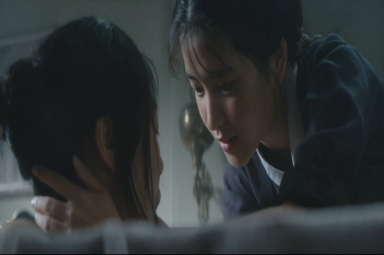
Figure 1: Grind the teeth
3.2. Sexuality
The Handmaiden (Park, 2016) chooses angles and camera techniques that highlight the female body. This is especially true during the sex scenes, which presents the female body as an object of visual pleasure [1]. For example, during the film’s intimate scenes, the camera often lingers on details of the female body, reinforcing the concept of women as objects of male desire. This approach satisfies the voyeuristic desires of the male gaze, which Mulvey [1] argues is central to traditional cinema. The lighting in The Handmaiden (Park, 2016) is designed to enhance the erotic aspects of the sex scenes. The warm lighting creates a sensual atmosphere that highlights the physical features of the female characters, which helps to enhance the visual appeal of the scene [2]. This approach exemplifies the deliberate eroticization of the female body for the audience’s pleasure, which is consistent with Mulvey’s [1] critique of how lighting and camera techniques objectify women. The editing style of The Handmaiden (Park, 2016) is also quite specific, aimed at enhancing the audience’s visual experience. The rapid editing and dynamic shots are a particularly cinematic rhythm that heightens the physicality and sexual tension of the scenes. This editing style aligns with Mulvey’s [1] concept of the male gaze, which focuses on the visual pleasure gained from the representation of the female body. The film’s editing choices contribute to creating a voyeuristic desire where the audience can derive pleasure from the objectification of the female characters.
In contrast, Fingersmith (Walsh, 2005) primarily uses medium and close-up shots of the characters’ facial expressions, shifting the focus from the physical features of the female characters to their inner experiences and interactions [4]. This approach challenges the concept of the male gaze by emphasizing the complex emotional lives of the characters rather than objects of desire. According to feminist criticism, this shift away from objectification reflects a broader challenge to the traditional male gaze [5]. The lighting in Fingersmith (Walsh, 2005) is soft and simple, creating an atmosphere of melancholy and intimacy that reflects the psychological states of the characters rather than enhancing their physical attractiveness. This choice contrasts with the erotic lighting of The Handmaiden (Park, 2016). Such lighting choices emphasize the emotional and narrative aspects of the scene rather than contributing to the objectification of the female characters. This approach is consistent with feminist perspectives that critique the male gaze by focusing on narrative depth and character development [4]. The play provides a counter-narrative logic to the objectification of The Handmaiden (Park, 2016). This editing style is consistent with feminist criticism that challenges the male gaze by emphasizing that narrative and character are more important than visual pleasure [5].
The cinematography of Fingersmith (Walsh, 2005) highlights the emotional intensity of the characters’ interactions and uses medium shots and close-ups of the characters’ faces to embody the subjectivity of the characters.
In The Handmaiden (Park, 2016), the bathing scene lingers on the details of the characters’ bodies, using close-ups and slow motion to emphasize their physical features. The use of slow motion brings the naked body closer, focusing on the skin, which objectifies the female body for the pleasure of the viewer [1]. The lighting in this scene is warm, creating an erotic atmosphere, which enhances the visual pleasure from representations of the female body [2].
In conclusion, Fingersmith (Walsh, 2005) focuses on emotional and psychological descriptions, challenging the conventions of traditional male gaze. However, The Handmaiden (Park, 2016) emphasizes body objectification and visual pleasure by close-ups, lighting, and dynamic editing, creating a more immersive experience of sex scenes through explicit nature and artistic composition, which satisfies desires and voyeurism of male viewers.
3.3. Betrayal
The majority of plot twists in the two films under discussion are related to betrayal. According to the chronological order, the plots about betrayal can be roughly divided into four parts: beginning, reversal, revenge, and redemption.
3.3.1. Beginning
The initial section of the narrative details the betrayal of the lady by her maid. In both films, the narrative is presented from the perspective of the maid, exposing a plan: The maid will help a man marry lady, and the two will share lady's possessions and eventually send lady to an insane asylum (the man is called gentlemen in Fingersmith (Walsh, 2005) and duke in The Handmaiden (Park, 2016) ). The distinction between the two films lies in the duration of the narrative devoted to the unfolding of this plan. Fingersmith (Walsh, 2005) relatively devotes a significant portion of its narrative to the contextualization of the plan's inception, with a particular emphasis on the profound connection between the maid and her foster mother. The maid considers the bond between herself and her foster mother, who is not related to her but has raised her, to be an expression of love. Consequently, the maid places her trust in her foster mother, which serves as a foundation for the subsequent episodes. Furthermore, this episode illustrates the significant role of numerous female characters in propelling the narrative. According to ‘Visual Pleasure and Narrative Cinema’ [1], male roles always actively drive the story forward in mainstream movies. In contrast, the introduction of the maid and the man's plan in The Handmaiden (Park, 2016) is relatively brief, with the narrative relying on flashbacks. This results in a reduction in the role of the female characters in advancing the narrative.
3.3.2. Reversal
The second part of the film depicts the betrayal of the maid by the lady. The narrative perspective shifts from the maid to the lady in both films, thereby offering the audience insight into the another plan devised by the lady and the man. This plan is a significant reversal of what the maid knew, as it is the maid, not the lady, who is actually being used. In this section, Fingersmith (Walsh, 2005) illustrates lady's concealed affection for the maid through the portrayal of lady's gaze directed towards the maid. In the scene of the lady's oil painting, the lady stares intently at the sleeping maid in the distance, unaware that the red paint in her hand has already polluted the canvas and stained her dress. The photograph of the lady's oblivious posture serves to illustrate the extent of her infatuation with the maid.
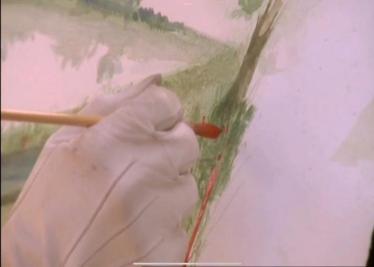
Figure 2: Oil painting
Similarly, in The Handmaiden (Park, 2016), the lady's gaze upon the maid is also captured on camera. However, this gaze is distinctively characterized by a male perspective. To illustrate, the scene in which the lady observes the maid through a hole can be interpreted as an expression of voyeuristic desire. From this perspective, the maid is objectified and becomes an object. The director demonstrates this voyeuristic perspective through the use of shaky camera techniques and partial close-ups of the maid's body, particularly her breasts. According to Laura Mulvey[1], the stark contrast between the darkness of the cinema and the glaring light of the moving light patterns on the screen also serves to engender the illusion of voyeurism. Therefore, it can be argued that the gaze in The Handmaiden (Park, 2016) sexualizes the female character to a greater extent than the gaze in Fingersmith (Walsh, 2005).
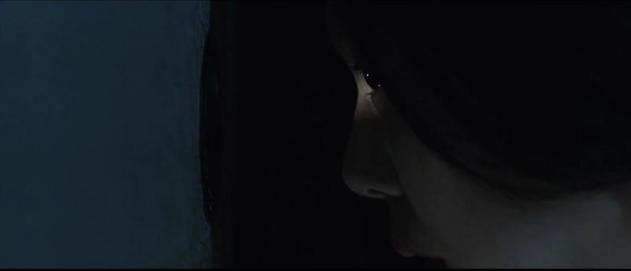
Figure 3: Observing
3.3.3. Revenge
In Fingersmith (Walsh, 2005), the betrayal of the maid by her foster mother is a key narrative element. The film reveals that the true architect of the scheme was Mrs. Sucksby, the maid's adoptive mother, driven by her desire to claim the property. This is revealed through Miss's perspective. This leads to the fact that the identities of the lady and the maid have been swapped. In the subsequent plot, the lady killed the gentleman. And Mrs.Sucksby, out of maternal love, decided to accept the death penalty on behalf of the young lady. The configuration of this plot demonstrates the impoverished characters' aspiration for pecuniary gain and the maternal figure's self-sacrificing love for her offspring. This contributes to the portrayal of female characters as complex beings, encompassing both human desires and an inner beauty of kindness.
However, The Handmaiden (Park, 2016) does not present a plot in which the two characters swap identities. Instead, the film's narrative revolves around the betrayal of the Duke by the lady and the maid. The two individuals confess their plans to each other due to their mutual affection and devise a method to evade the duke's control and attain autonomy. Subsequently, the duke kills the lady’s uncle and then commit suicide. The deaths of the two most important male characters are situated within the context of a struggle for power. Waters posits that Victorian literary plots are themselves heteropatriarchal, which serves to reinforce the power of male characters [7]. In works where male characters, rather than female characters, realize the deaths of villainous characters, traces of heteropatriarchal narrative structures can be observed in the treatment of this plot. An example of this can be seen in The Handmaiden (Park, 2016). Conversely, Fingersmith (Walsh, 2005) challenges the conventional heteropatriarchal narrative structure. In this cinematic work, the male protagonist is killed by the female protagonist. Therefore, the female protagonist becomes to the central figure of the narrative.
3.3.4. Redemption
In both films' conclusions, the lady and her maid engage in a homosexual relationship, which challenges the heteronormative order. Both Fingersmith (Walsh, 2005) and The Handmaiden (Park, 2016) feature episodes of the destruction of pornographic novels. The key distinction is that in Fingersmith (Walsh, 2005), it is the lady herself who destroys the book. In contrast, in The Handmaiden (Park, 2016), it is the maid who initiates the destruction of the books, thereby establishing lady as an object in need of rescue. Laura Mulvey [1] states that men unconsciously seek to escape through the rescue of guilty objects, thereby alleviating castration complex anxiety. The episode of the maid's rescue of the lady is a fitting example of this phenomenon. In the scene set in the study, there is a distinct delineation between the study and the external world. In Fingersmith (Walsh, 2005), this boundary is represented by a pattern of fingers. In Park's 2016 film, The Handmaiden, the boundary is represented by a statue of a snake. Freud [8] notes that the snake is a symbol of male genitalia and sexuality. It can therefore be argued that the sculpture of the snake in The Handmaiden (Park, 2016) is characterized by sexual innuendo.
In conclusion, the aforementioned analysis demonstrates that films created by male directors tend to rely more heavily on male characters to propel the narrative. The rationale behind female characters' betrayal is simplified by male directors, whereas female directors present a more nuanced portrayal of human emotion. Conversely, the male director's filmography displays a greater prevalence of sexual elements.
3.4. Closure
At the closure of Fingersmith (Walsh, 2005), Sue returns to Briar in search of Maud. After meeting in a study, Maud reads her own pornographic novel aloud to Sue, intending to reveal truths about herself, who only writes pornographic novels. However, Sue accepts the real Maud. They assume a prone position and retrieve the paper on the ground. Sue inquires as to the content of the paper, to which Maud responds that it is inscribed with the phrases "How I want you" and "How I love you." Subsequently, they kissed at the desk, bathed in sunlight streaming through the window. Therefore, it is evident that the portrayal of the relationship between them is multifaceted, proving that female directors' approaches may tend to offer more nuanced representations of lesbian relationships[9].
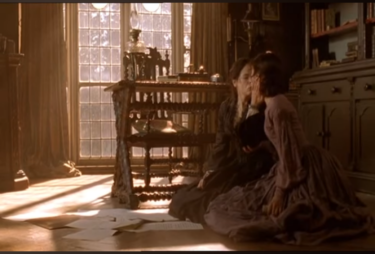
Figure 4: Kissing
While as Shamoon [5] stated that male gaze tends to exploit and sensationalise lesbian relationships, portraying them as salacious, The Handmaiden (Park, 2016) ends up in a tantalising sexual intercourse. After escaping the control of the Uncle and the Count, Hideko and Sook-hee flee Shanghai by vessel. In the final scene, they have a lascivious sex session in the cabin of the vessel. Kim [10] argued that the steamy sexuality scene in the closure of The Handmaiden (Park, 2016) is more like a pornographic showtime, which caters to the audience’s sexual fantasies. The sex scene teases and satisfies the viewers' male gaze on female body and lesbian sexuality.
The object of the viewer's sexual fantasy is a sexual spectacle that can be observed [11]. That is the male gaze traditionally objectifies and sexualises women through a heterosexual and voyeuristic lens [12]. Therefore, male gaze exerts a significant influence on heterosexual male directors, who may sexualise and objectify lesbian characters when portraying lesbian relationships, so that they are inevitably shaped by male director as objects of the male gaze in the eyes of the viewer, losing their subjectivity and agency.
At the closure of Fingersmith (Walsh, 2005), Sue and Maud kiss in a study. The right half of the frame is in shadow, while the left half is illuminated by sunlight streaming through the window. The overall tone of the shot and the set-up evoke a sense of pleasant solemnity. The composition integrates them with the whole scene, with their attire echoing the surrounding set-up. The background music in the closure is tranquil and moving, resonating with the profound affection between them. The shot evokes a sense of love and normal and peaceful relationship.
However, in The Handmaiden (Park, 2016), despite the lack of extensive use of 'voyeuristic' angles in the sex scene of the closure, a full shot is employed to situate them at the centre of the screen, thereby revealing the curvaceous forms of their bodies. Furthermore, the full shot is symmetrical, featuring identical props such as chairs, windows, and lamps. The setting of the sexual encounter is akin to a stage, which lends the scenes a quality of a performance. The overall dark colour contributes to the atmosphere of mystery and voyeurism, which aligns with the male desire, thereby positioning the viewer as a voyeur. Additionally, the film incorporates close-up shots of the female naked bodies, including views of breasts and smooth skin. While this aestheticised display of the bodies enhances the appreciation of specific scenes, it simultaneously reinforces the sexualisation and objectification of female body, which caters to the male gaze, just as the actresses in The L-Word (Dickerson, 2004) conform to male standards of female beauty [13]. Furthermore, the provocative background music satisfies male gaze, thereby enhancing the overall spectacle and pleasure derived from the sexual acts depicted.
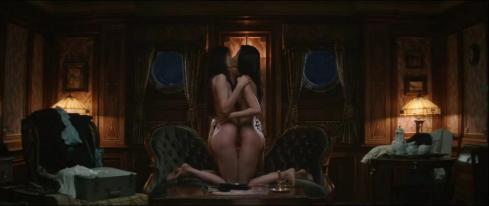
Figure 5: Sex
The bells serve as a symbol throughout the cinema, representing the control and oppression of traditional society and the discipline imposed upon them. In the closure, they utilise the bells as a means of facilitating sexual intercourse. While this may be seen as an indication that they are no longer constrained by past traditions and are now free, symbols such as the bells are still sexualised, making it challenging for the audience to move beyond a sexualised interpretation of these symbols. The shot of they sucking on the bells can be interpreted as a form of worship directed towards a male figure. This act may elicit a hidden pleasure for the male viewer, as it is reminiscent of sucking on testicles. While this method of filming and portrayal has a positive effect on the cinema's plot and main topic, it also inadvertently caters to the male gaze by objectifying and sexualising meaningful symbols.

Figure 6: Bells
The closures of the two cinemas are approached in markedly disparate manners, maybe largely due to the influence of the directors' gender. The Handmaiden (Park, 2016) presents a pronounced male gaze in its closure, which may be an reflection of the director's gender on male gaze.
4. Conclusion
This paper presents a detailed analysis of differences between the narrative and visual strategies employed in Fingersmith (Walsh, 2005) and The Handmaiden (Park, 2016), from intimacy, sex, betrayal, and closure. This study argues that Park, as a male director, is unable to wholly circumvent the male gaze in their own cinematic works. Even in films that depict lesbian romantic relationships, female characters continue to be sexualized and objectified by Park. In contrast, Walsh as a female directors focus more on the subtle inner portrayal of female characters. This indicates that the gender of the director is an important factor affecting film production. According to this conclusion, more research is needed on the impact of director gender on film narrative and visual effects. This paper not only enhances comprehension of gender dynamics, but also offers valuable insights for directors seeking to create films that challenge the heteropatriarchal framework.
References
[1]. Mulvey, L. (2013). Visual pleasure and narrative cinema. In Feminism and film theory (pp. 57-68). Routledge.
[2]. Wheeler, K. L. (2017). Examining sex and climaxes in Blue is the Warmest Color and Carol.
[3]. Krauthaker, M., & Connolly, R. (2017). Gazing at Medusa: adaptation as phallocentric appropriation in Blue Is the Warmest Color. European Comic Art, 10(1), 24-40.
[4]. White, P. A. (1993). The uninvited: Cinema and the conditions of lesbian representability.(Volumes I and II). University of California, Santa Cruz.
[5]. Shamoon, D. (2021). Class S: appropriation of ‘lesbian’subculture in modern Japanese literature and New Wave cinema. Cultural Studies, 35(1), 27-43.
[6]. White, P. (1999). Uninvited: Classical Hollywood cinema and lesbian representability. Indiana University Press.
[7]. Lee, J. J. (2018). Queer Inventions: Rupturing Narrative Hegemony in Sarah Waters' Fingersmith. Nineteenth-Century Gender Studies, 14(3).
[8]. Freud, S. (1983). The interpretation of dreams. In Literature and Psychoanalysis (pp. 29-33). Columbia University Press.
[9]. Cicek, F. (2012). From Margins to the Center Through the Film Lens: Gender and Turkish-German Cinema (Doctoral dissertation, [Bloomington, Ind.]: Indiana University).
[10]. Kim, S. Y. (2020). Unethical Adaptation: Indigenization and Sex in Chan-wook Park’s The Handmaiden (2016). Adaptation, 13(1), 1-12.
[11]. Stacey, J. (1988). Desperately seeking difference.
[12]. Muzart, T. (2022). Girlhood Through a Glass Queerly. Contemporary French and Francophone Studies, 26(4-5), 481-489.
[13]. Wolfe, S. J., & Roripaugh, L. A. (2006). Feminine Beauty and the Male Gaze in The L-Word. MP: An International Feminist Online Journal, 1(4), 1-7.
Cite this article
Yue,X.;Hu,Z.;Yin,J. (2025). Male Gaze in Fingersmith: How the Director's Gender Impacts the Visual and Narrative Style of Cinema about Lesbian. Communications in Humanities Research,70,76-84.
Data availability
The datasets used and/or analyzed during the current study will be available from the authors upon reasonable request.
Disclaimer/Publisher's Note
The statements, opinions and data contained in all publications are solely those of the individual author(s) and contributor(s) and not of EWA Publishing and/or the editor(s). EWA Publishing and/or the editor(s) disclaim responsibility for any injury to people or property resulting from any ideas, methods, instructions or products referred to in the content.
About volume
Volume title: Proceedings of the 3rd International Conference on Interdisciplinary Humanities and Communication Studies
© 2024 by the author(s). Licensee EWA Publishing, Oxford, UK. This article is an open access article distributed under the terms and
conditions of the Creative Commons Attribution (CC BY) license. Authors who
publish this series agree to the following terms:
1. Authors retain copyright and grant the series right of first publication with the work simultaneously licensed under a Creative Commons
Attribution License that allows others to share the work with an acknowledgment of the work's authorship and initial publication in this
series.
2. Authors are able to enter into separate, additional contractual arrangements for the non-exclusive distribution of the series's published
version of the work (e.g., post it to an institutional repository or publish it in a book), with an acknowledgment of its initial
publication in this series.
3. Authors are permitted and encouraged to post their work online (e.g., in institutional repositories or on their website) prior to and
during the submission process, as it can lead to productive exchanges, as well as earlier and greater citation of published work (See
Open access policy for details).
References
[1]. Mulvey, L. (2013). Visual pleasure and narrative cinema. In Feminism and film theory (pp. 57-68). Routledge.
[2]. Wheeler, K. L. (2017). Examining sex and climaxes in Blue is the Warmest Color and Carol.
[3]. Krauthaker, M., & Connolly, R. (2017). Gazing at Medusa: adaptation as phallocentric appropriation in Blue Is the Warmest Color. European Comic Art, 10(1), 24-40.
[4]. White, P. A. (1993). The uninvited: Cinema and the conditions of lesbian representability.(Volumes I and II). University of California, Santa Cruz.
[5]. Shamoon, D. (2021). Class S: appropriation of ‘lesbian’subculture in modern Japanese literature and New Wave cinema. Cultural Studies, 35(1), 27-43.
[6]. White, P. (1999). Uninvited: Classical Hollywood cinema and lesbian representability. Indiana University Press.
[7]. Lee, J. J. (2018). Queer Inventions: Rupturing Narrative Hegemony in Sarah Waters' Fingersmith. Nineteenth-Century Gender Studies, 14(3).
[8]. Freud, S. (1983). The interpretation of dreams. In Literature and Psychoanalysis (pp. 29-33). Columbia University Press.
[9]. Cicek, F. (2012). From Margins to the Center Through the Film Lens: Gender and Turkish-German Cinema (Doctoral dissertation, [Bloomington, Ind.]: Indiana University).
[10]. Kim, S. Y. (2020). Unethical Adaptation: Indigenization and Sex in Chan-wook Park’s The Handmaiden (2016). Adaptation, 13(1), 1-12.
[11]. Stacey, J. (1988). Desperately seeking difference.
[12]. Muzart, T. (2022). Girlhood Through a Glass Queerly. Contemporary French and Francophone Studies, 26(4-5), 481-489.
[13]. Wolfe, S. J., & Roripaugh, L. A. (2006). Feminine Beauty and the Male Gaze in The L-Word. MP: An International Feminist Online Journal, 1(4), 1-7.





